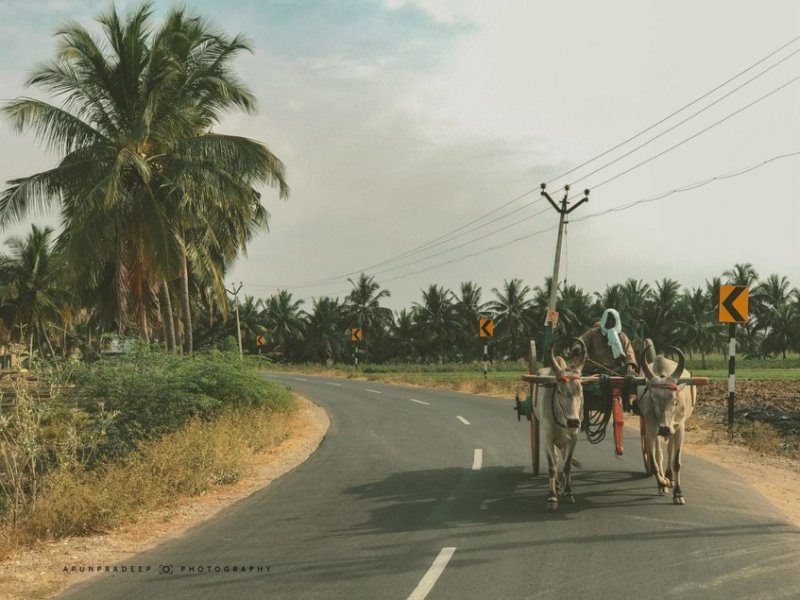Better Rural Transport is Key to Food Security and Zero Hunger
This blog post was originally released by the Research for Community Access Partnership (ReCAP) in here. A french version of the blog post is available here.
From 6 to 17 November 2017, the United Nations has convened its Climate Change Conference (COP23) in Bonn, Germany, where nations of the world will meet to advance the aims and ambitions of the Paris Agreement and achieve progress on its implementation guidelines. On Tuesday 14 November, ReCAP has co-organised, and participated in, a high level Round Table on “Rural Transformation: Climate Resilient and Low Emission Food Systems”. The Round Table addressed Sustainable Development Goal 2: Zero Hunger, by linking food security to sustainable agriculture, rural access & transport and rural-urban linkages and renewable energy. ReCAP, in collaboration with the Partnership on Sustainable Low Carbon Transport (SLoCaT) and other partners, such as the UN Food and Agriculture Organisation (FAO) and the Global Resilience Partnership (GRP), contributed on the topic of what changes are needed in rural access and transport infrastructure to contribute to enhanced food security and reduced emissions.
We are excited to be represented at such a prominent and high-level occasion. In the run up, we are pleased to share with you a blog post on the theme by Mr Manu Sasidharan, postgraduate research student, Rural Roads Research Group, University of Birmingham.
The Roads Research Group in Civil Engineering at the University of Birmingham, United Kingdom, has over the last 50 years built a world-leading centre of excellence in research, education and capacity building in and with low-income countries, including Sub-Saharan Africa (SSA) and South East Asia. The Group’s research and capacity building in Rural Roads focus is on the provision of safe, reliable, economic and climate-resilient rural access to support the growth of developing economies. Asset management and geotechnical engineering are its two principal research areas. Evidence of the Group’s track record and excellence was recently recognised by The UK Collaborative on Development Sciences (UKCDS).

Our blogger is Manu Sasidharan. Manu is a PhD Researcher within the School of Civil Engineering, focusing on developing an integrated risk and asset management framework to aid predictive maintenance of linear infrastructure. He is involved in the capacity of Research Assistant with the Rural Roads Group where he is currently working on a research project for the ReCAP-SLoCaT collaboration. In addition, Manu is the Centre Development Lead for the India Centre for Urbanism Research and Education, which is being established in collaboration with universities, government agencies and business incubators to aid the Smart City Mission of India.
Better Rural Transport is Key to Food Security and Zero Hunger
By Manu Sasidharan, PhD Researcher, School of Civil Engineering, University of Birmingham
Road infrastructure and the associated provision of safe, reliable, and affordable transport services in rural areas, have the potential to bring about social and economic development, thereby reducing poverty, increasing food security and productivity and lessening the experience of hunger [1-7]. Yet nearly one billion rural residents, approximately 68% of the world’s rural population, still do not have all-season access to road networks [3].
Rural economies in developing countries are predominantly agrarian, with supply chains and supporting infrastructure to enable access to markets. However, approximately 45% of the land area in low income countries and 51% in lower middle-income countries are located more than five hours away from the main market, severely constraining the potential of agriculture to help to meet local food needs [6].

Improved all-season road infrastructure and the availability of transport services are effective ways to increase food security and curb hunger, as it allows farmers to sell their produce to a larger market, more frequently during the year, at competitive prices. It furthermore enables the goods and services which support farming to reach farms more efficiently and at less cost. Good all-season access improves the efficiency of food distribution, by providing better connectivity throughout the year and lower transport costs via shorter journey times, lower fuel consumption rates and less vehicle wear and tear [12]. In turn, these enable reductions in costs, wastage and damage of produce during transportation (i.e. post-harvest loss)[5]. For example, poor road links were shown to increase transport costs greatly in parts of rural Tanzania6, while improved road condition reduced the transport costs of bananas in Kenya by 14% [1].
Good access enables farm yields to increase and production costs to decrease by facilitating access to fertilisers, mechanised equipment and high-yield seed varieties and enabling supporting activities including labour, agricultural extension workers and veterinary services to reach farms more easily, thus directly improving food security and reducing hunger. For example, investment in rural roads contributed to approximately 25% of agricultural produce growth in India during the 1970s and was responsible for the largest impact in poverty reduction.
Good rural access positively impacts the development of the rural economy and indirectly leads to improved food security and zero hunger. For example, improved access leads to a rise in the profits realised by local producers, and therefore their purchasing power, by reducing post-harvest losses and transport costs to competitive input markets and remunerative output markets. It encourages the development of local markets, small-scale businesses and farming, as demonstrated in Vietnam, where improved rural access was shown to increase the number of local markets [9] and in India, where improved road access helped farmers set up small non-farm businesses and market their products beyond their villages and towns [10]. Employment opportunities for rural inhabitants are also closely linked to improved rural transport infrastructure. Daily waged employees and migrant labourers often rely on bicycles and buses for their travel [2]. Similarly, these modes enable mobility of the more vulnerable social groups (for example, women, children and older people). Thus, good access also serves as an enabling factor in income generation and the fulfilment of daily tasks.
From the above it may be concluded that rural transport, if made affordable, reliable and accessible, has a positive impact on improving food security and ensuring zero hunger. Transport policies and programmes can make it easier for low-income families, farmers and people with poor nutrition to access markets and source affordable food. Increased rural connectivity not only contributes to the increase in agricultural productivity by market access, but also enables empowerment of women and children. It can help revitalize rural neighbourhoods by providing access to adequate, safe and nutritious food. Hence, reliable rural transport networks can facilitate an increase in the efficiency of food production, processing, preservation and distribution contributing to zero hunger and food security.
———-
This blog post was originally released by the Research for Community Access Partnership (ReCAP) in here. A french version of the blog post is available here.
This blog post is part of a set of Key Messages on Rural Transport and Sustainable Development Goals developed in the framework of the UKAid funded Research for Community Access Partnership (ReCAP), facilitated by the Partnership on Sustainable, Low Carbon Transport (SLoCaT). More details on the key messages can be found in the associated factsheet and supporting paper.
References
1. AFCAP, 2013, ‘A planning framework for improving the efficiency of transport services in the high value agricultural sub-sector, replicable in other values chains’, Project AFCAP/GEN/060: Work Package 3 (Deliverable 5) Report
2. Asian Development Bank, 2002, ‘Impact of Rural Roads on Poverty Reduction: A Case Study Based Analysis’, IES: REG 2002-15
3. A. Limi, F. Ahmed, E. C. Anderson, A. S. Diehl, L. Maiyo, T. Peralta-Quiros, K. S. Rao, 2016, ‘New Rural Access Index – Main Determinants and Correlation to Poverty’, Washington D.C., World Bank Group
4. M. Blimpo, R. Harding, L. Wantchekon, 2012, ‘Public Investment in Rural Infrastructure Some Political Economy Considerations’, African Human Development Report, United Nations Development Programme
5. B. Lipinski, C. Hanson, J. Lomax, L. Kitinoja, R. Waite, T. Searchinger, 2013, ‘Reducing Food Loss and Waste’, Washington D.C., Instalment 2 of Creating a Sustainable Food Future, World Resources Institute
6. N. Seiber, 2009, ‘Freight Transport for Development Toolkit: Rural Freight’, Washington D.C., The International Bank for Reconstructions and Development, The World Bank
7. P. Starkey, J. Hine, 2014, ’Poverty and Sustainable Transport: Literature Review’, London, Department for International Development
8. Rabobank, 2015, ‘Access to financial services in developing countries’, The Rabobank View
9. S. Fan, T. Olofinbiyi, S. Gemessa, 2015, ‘Ending Hunger and Undernutrition by 2025’, The Fight Against Hunger and Malnutrition: The Role of Food, Agriculture and Targeted Policies, Oxford University Press
10. S. Fan, P. Hazell, S. Thorat, 2000, ‘Government Spending, Growth and Poverty in Rural India’, American Journal of Agricultural Economics 82 (4), pp 1038-1051
11. S. Fan, C. Chan-Kang, A. Mukherjee, 2005, ‘Rural and Urban Dynamics and Poverty: Evidence from China and India’, Washington D.C., International Food Policy Research Institute
12. T. Lacroix, 2011, ‘Migration, rural development, poverty and food security: A comparative perspective’, International Migrations Institute, University of Oxford
The views expressed in this blog post are of the author only and do not necessarily reflect the views of ReCAP or Cardno Emerging Markets (UK) Ltd, for whom the post was prepared.